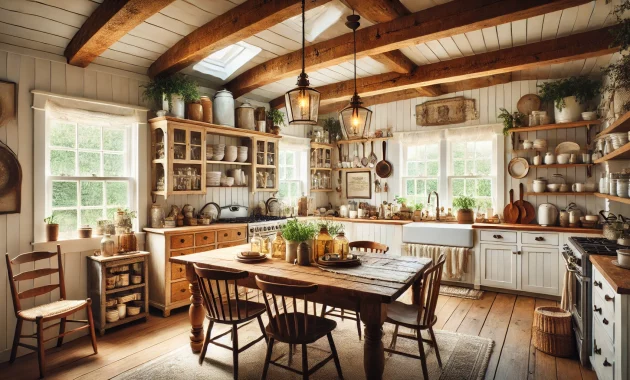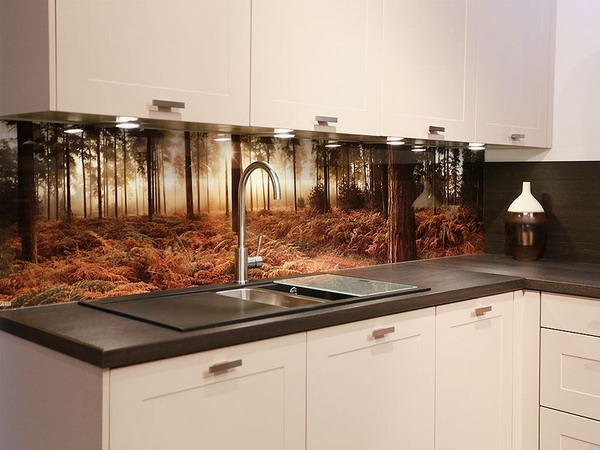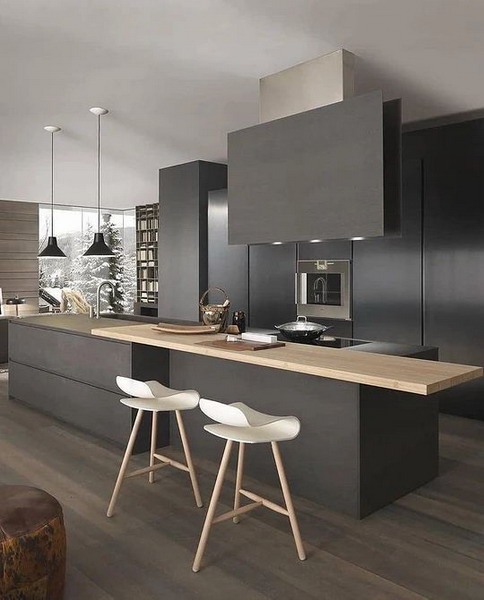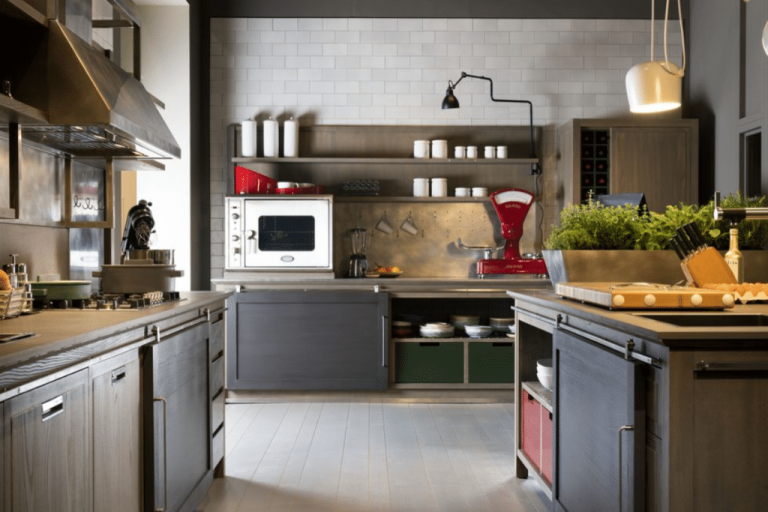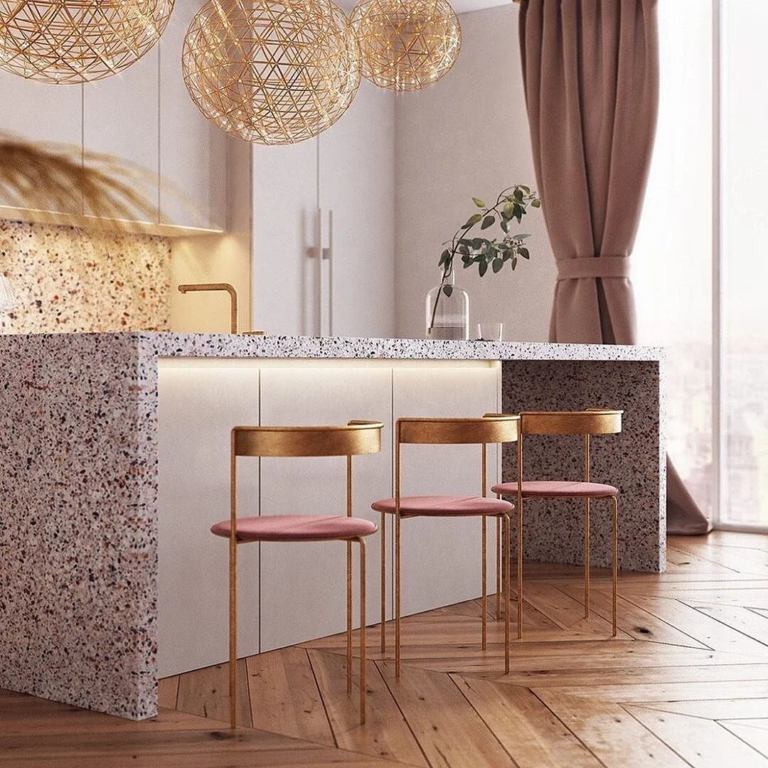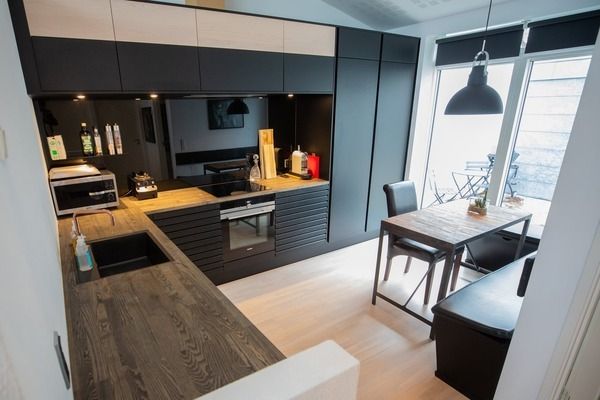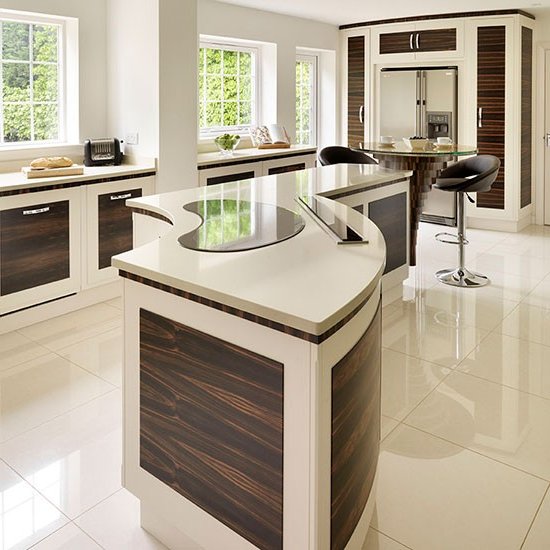Farmhouse Kitchen Decor Ideas: Transform Your Space with Timeless Charm
A farmhouse kitchen is a blend of comfort and nostalgia, making it a popular choice for many homeowners. Incorporating elements such as rustic wood, vintage accessories, and a neutral color palette can transform a standard kitchen into a warm, inviting space. These design choices reflect a simpler lifestyle while maintaining modern functionality.
Adding personal touches through decor can enhance the farmhouse aesthetic. Items like open shelving, ceramic dishware, and farmhouse-style lighting fixtures create a cohesive look that celebrates both practicality and style.
As trends evolve, the key to a successful farmhouse kitchen lies in balancing modern conveniences with timeless charm. By focusing on materials and decor that evoke warmth and individuality, anyone can achieve this sought-after look.
Contents
Defining Farmhouse Kitchen Decor
Farmhouse kitchen decor blends rustic charm with practicality, reflecting a lifestyle that values simplicity and warmth. This style draws inspiration from historical influences while incorporating modern elements.
Historical Influences
Farmhouse decor originated in rural areas where functionality was paramount. Early American settlers emphasized creating a warm, inviting space, often using reclaimed wood, thrifted items, and handmade crafts. Materials like shiplap and barn doors became staples, representing a connection to the land and simpler times.
Common motifs include vintage cookware, weathered furniture, and hand-painted signs. Earthy colors dominate, with whites, greens, and browns defining the palette. This style is a nod to the past while emphasizing a lived-in feel, making kitchens not just functional spaces but also gathering spots.
Modern Vs. Traditional Styles
The modern farmhouse kitchen decor balances contemporary trends with traditional elements. While classic styles focus heavily on rustic charm, modern interpretations introduce sleek lines and minimalist features.
Key differences include:
- Materials: Modern designs often incorporate stainless steel appliances alongside wood accents.
- Color Schemes: Bright whites may dominate in a modern setting, while traditional styles favor muted tones.
- Layout: Open-concept designs are common in modern representations, promoting interaction and flow.
The blend of these styles allows homeowners to personalize their kitchens, creating spaces that are both functional and aesthetically pleasing.
Color Schemes and Materials
Color schemes and materials are crucial elements in creating a farmhouse kitchen aesthetic. The right palette can evoke a sense of warmth, while natural materials enhance the rustic charm. Exploring these aspects helps in crafting a cohesive and inviting environment.
Choosing a Color Palette
A farmhouse kitchen often embraces earthy tones and soft neutrals. Shades like creamy whites, soft grays, and muted greens can create a calming backdrop. To add dimension, consider accent colors such as navy blue or barn red.
Tips for selecting the palette:
- Test paint samples in natural light to see how colors change throughout the day.
- Harmonize with cabinetry and countertops to ensure a cohesive look.
- Utilize pops of color through accessories or textiles for visual interest.
These choices provide a balance between simplicity and warmth, essential for farmhouse decor.
Natural Materials and Textures
Incorporating natural materials fosters authenticity in farmhouse kitchens. Wood, stone, and metal are commonly used for cabinetry, countertops, and decor items. They bring texture and character to the space.
Key materials to consider:
- Wood: Opt for reclaimed or distressed wood to add a rustic feel.
- Stone: Consider granite or butcher block for countertops, providing durability and style.
- Metal accents: Use wrought iron or brushed nickel for fixtures and hardware.
Mixing these textures contributes to a layered, inviting ambiance that defines farmhouse design.
Furniture Selection
Choosing the right furniture is essential for creating an inviting farmhouse kitchen. Key elements include selecting practical tables and seating as well as incorporating distinctive statement pieces that complement the decor.
Tables and Seating Options
When selecting tables, consider materials like reclaimed wood for an authentic farmhouse feel. Rustic farmhouse tables often feature sturdy construction and wide planks, ideal for both style and functionality. A round table can encourage conversation, while a rectangular one offers ample space for dining or meal prep.
For seating, opt for mismatched chairs or benches that enhance the eclectic charm. Wooden stools with a distressed finish can complement a kitchen island, while upholstered chairs add comfort around the dining table. Colorful cushions can inject personality and warmth into seating arrangements.
Statement Pieces
Incorporating statement pieces can elevate the farmhouse kitchen’s aesthetic. Items like a vintage hutch or a large, ornate clock serve as focal points. A farmhouse sink or an antique sideboard can blend utility with character, making them excellent choices.
Additionally, open shelving allows for display opportunities. Arrange rustic pottery, cookbooks, or heirloom dishes to add visual interest. Choosing a farmhouse-style light fixture, such as a wrought iron chandelier, provides a striking accent while enhancing the overall ambiance.
Lighting and Fixtures
Effective lighting and carefully selected fixtures play a vital role in enhancing the farmhouse kitchen ambiance. The right choices can create warmth and showcase the kitchen’s rustic charm.
Pendant Lights and Chandeliers
Pendant lights and chandeliers add character and elegance to the farmhouse kitchen. Materials like wrought iron, wood, and glass are commonly used, aligning with the rustic aesthetic. For instance, a large wrought iron chandelier can serve as a stunning focal point above the dining table.
Height matters when installing these fixtures. Pendant lights should hang 30 to 36 inches above the countertop or island for optimal illumination. Additionally, a mix of light temperatures—such as warm white for a cozy atmosphere—can enhance the overall feel of the space.
Layered lighting can also be beneficial. Combining overhead lighting with under-cabinet lights provides both functionality and style. This allows for enhanced visibility while preparing food, making pendant lights and chandeliers not just decorative, but also practical.
Cabinet Hardware Choices
Choosing the right cabinet hardware complements the farmhouse kitchen’s design. Brass, matte black, and distressed finishes are popular choices that evoke a rustic feel. Aged brass handles can add a touch of elegance, while matte black pulls can offer a contemporary twist.
Size and style are key in selecting hardware. Larger handles can provide a bold look, while smaller knobs may lend a subtler touch. Mixing styles—such as pairing vintage knobs with sleek pulls—can create an eclectic yet cohesive appearance.
Installation placement is crucial for functionality. Hardware should be centered on cabinet doors and drawers, ensuring ease of use. Careful selection and placement of cabinet hardware enhance both the aesthetic and functionality of the farmhouse kitchen.
Textiles and Accents
Textiles and accents play a vital role in enhancing the farmhouse kitchen aesthetic, adding warmth and character. The right choices can transform a utilitarian space into a welcoming hub for family and friends.
Curtains and Rugs
Curtains in a farmhouse kitchen often feature light, airy fabrics like linen or cotton with patterns such as checks or florals. These materials allow natural light to filter through while adding a touch of rustic charm.
Rugs can anchor the space, providing comfort underfoot. Opt for jute or sisal rugs for a natural look, or choose a vintage-style patterned rug to introduce color and texture.
Some popular ideas include:
- Layering: Combine a larger, neutral rug with smaller patterns for depth.
- Color Palette: Stick to earthy tones like greens, browns, and creams to maintain a cohesive look.
Decorative Accessories
Decorative accessories can significantly enhance the farmhouse vibe. Items such as woven baskets, wooden cutting boards, and ceramic dishware add texture and functionality.
Wall art featuring botanical prints or vintage signs can personalize the space. Incorporating elements like metal accents in light fixtures or shelving units can balance softer textiles.
Consider these options:
- Table Settings: Use cloth napkins and handmade pottery for dining.
- Display: Arrange seasonal decor on open shelving to keep the kitchen feeling fresh.
By carefully selecting textiles and accents, a farmhouse kitchen can become a harmonious blend of style and comfort.
Essential Storage Solutions
Effective storage solutions enhance both functionality and style in a farmhouse kitchen. By utilizing clever designs, one can maximize space while keeping essential items accessible and decorative.
Open Shelving
Open shelving provides a practical and aesthetic solution for farmhouse kitchens. It allows for easy access to frequently used items, such as dishes or cooking utensils.
Benefits of Open Shelving:
- Visual Appeal: Displaying beautiful dishware or rustic jars adds character.
- Easy Organization: Items are visible, making it simpler to maintain order.
To maximize the space, consider varying shelf heights. This allows for larger items, such as mixing bowls, and smaller ones, like spice containers, to coexist seamlessly. Choosing materials like reclaimed wood or vintage metal can enhance the farmhouse feel.
Built-In Organization
Built-in organization integrates storage directly into the kitchen’s design, enhancing both efficiency and style. Customized cabinets, drawers, and nooks can be tailored to fit specific needs.
Key Features of Built-In Organization:
- Maximized Space: Utilizes every nook and cranny of the kitchen.
- Customized Solutions: Drawers for utensils, pull-out shelves for pots, and dedicated spice racks can be designed.
Investing in pull-out drawers and lazy Susans can improve accessibility. Moreover, integrating baskets or bins within cabinets keeps everything orderly and easy to find. This approach allows a farmhouse kitchen to remain both charming and functional.
Walls and Backsplash
Choosing the right walls and backsplash elements can significantly enhance the farmhouse kitchen aesthetic. It involves selecting appropriate colors, treatments, and materials that echo rustic charm and comfort.
Paint and Wall Treatments
For walls, soft, muted colors are ideal in a farmhouse kitchen. Shades like cream, sage green, or soft blue create a warm and inviting atmosphere.
Textured wall treatments such as shiplap or beadboard add depth and a classic look. Installing these materials can create an authentic farmhouse feel. Using semi-gloss paint can facilitate easy cleaning, especially crucial in kitchens.
Accent walls can introduce a focal point while maintaining balance. A well-chosen wallpaper pattern with florals or checks may also contribute to a rustic ambiance. Overall, mixing different textures while keeping a cohesive color palette is essential in achieving a true farmhouse aesthetic.
Backsplash Ideas
The kitchen backsplash serves both functional and aesthetic purposes in a kitchen. A popular choice is subway tiles, often used in traditional white or soft pastel finishes. They offer a clean look and allow for various design options.
Mosaic tiles in earthy tones can contribute texture and visual interest. Consider incorporating materials such as natural stone or wood for an organic touch.
For a unique flair, tin tiles can provide a vintage element while being easy to maintain. Open shelving above the backsplash can showcase decorative items and herbs, enhancing the rustic vibe. Mixing materials or patterns can create visual variety while still feeling cohesive with the overall decor.
Incorporating Greenery
Adding greenery to a farmhouse kitchen elevates its charm and enhances the atmosphere. Plants can serve both functional and decorative purposes, contributing to a cozy, inviting space.
Indoor Herb Garden
An indoor herb garden is a practical choice for a farmhouse kitchen. Herbs like basil, rosemary, and thyme thrive in sunlight and can be conveniently accessed for cooking.
Placement Ideas:
- Windowsills: Use trays to hold small pots of herbs, allowing for easy access and ample sunlight.
- Hanging Planters: Utilize wall space with hanging pots to create vertical interest while saving counter space.
Using small terracotta pots adds rustic appeal. Alternatively, repurposed jars can serve as charming and functional planters, aligning with the farmhouse aesthetic.
Potted Plants as Decor
Potted plants can enhance the decor and introduce color to a farmhouse kitchen. Varieties like peace lilies or snake plants are popular due to their low maintenance.
Styling Tips:
- Mix Heights and Textures: Combine plants in various heights and textures to add depth.
- Groupings: Use cluster arrangements on shelves or counters for visual impact.
Opt for simple, neutral pots to enhance the rustic vibe. Mixing ceramic and wooden planters can also tie in other design elements present in the kitchen.
